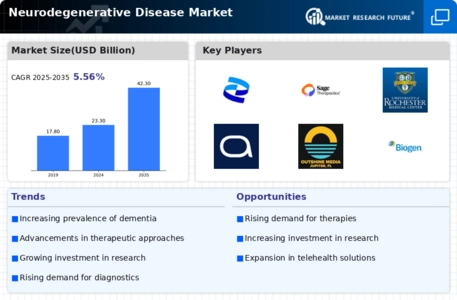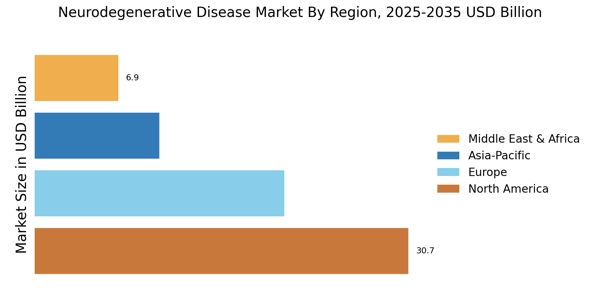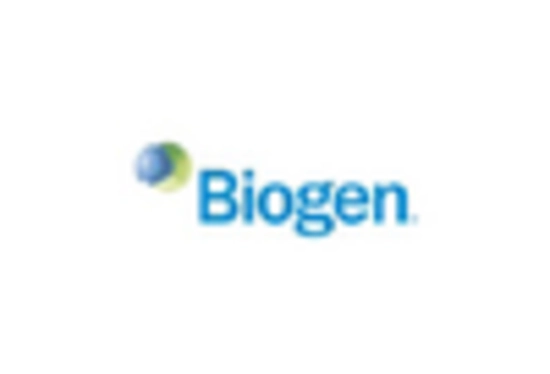Growing Awareness and Advocacy
The Neurodegenerative Disease Market is witnessing a rise in awareness and advocacy efforts aimed at educating the public and policymakers about these debilitating conditions. Organizations dedicated to neurodegenerative diseases are actively promoting research funding and support for affected individuals and families. This heightened awareness is likely to lead to increased funding for research initiatives, as well as improved access to care and support services. Furthermore, public campaigns are fostering a better understanding of the symptoms and challenges associated with neurodegenerative disorders, which may encourage earlier diagnosis and intervention. As advocacy efforts continue to gain momentum, the Neurodegenerative Disease Market is expected to benefit from a more informed public and increased governmental support.
Emergence of Digital Health Solutions
The Neurodegenerative Disease Market is increasingly influenced by the emergence of digital health solutions. Technologies such as telemedicine, mobile health applications, and wearable devices are transforming the way patients manage their conditions. These innovations facilitate remote monitoring and provide patients with tools to track their symptoms and medication adherence. The market for digital health solutions is projected to grow substantially, with estimates suggesting it could reach tens of billions in the coming years. This trend not only enhances patient engagement but also allows healthcare providers to deliver more personalized care. As digital health continues to evolve, it is likely to play a pivotal role in the Neurodegenerative Disease Market, improving patient outcomes and streamlining care delivery.
Advancements in Research and Development
The Neurodegenerative Disease Market is bolstered by significant advancements in research and development. Recent breakthroughs in understanding the pathophysiology of neurodegenerative diseases have paved the way for novel therapeutic approaches. For instance, the identification of biomarkers for early diagnosis and the development of disease-modifying therapies are transforming treatment paradigms. Investment in R&D is expected to reach unprecedented levels, with estimates indicating that funding for neurodegenerative research could surpass billions annually. This influx of resources is likely to accelerate the discovery of innovative drugs and therapies, thereby enhancing the overall landscape of the Neurodegenerative Disease Market. As a result, stakeholders are increasingly optimistic about the potential for new treatment options that could improve patient outcomes.
Aging Population and Increased Incidence
The Neurodegenerative Disease Market is experiencing a notable surge due to the aging population. As individuals age, the risk of developing neurodegenerative disorders such as Alzheimer's and Parkinson's increases significantly. Current estimates suggest that by 2030, the number of people aged 65 and older will reach approximately 1.4 billion, which could lead to a corresponding rise in neurodegenerative diseases. This demographic shift is likely to drive demand for innovative treatments and care solutions within the Neurodegenerative Disease Market, as healthcare systems adapt to manage the growing patient population. Furthermore, the economic burden associated with these diseases is substantial, with costs projected to exceed trillions in healthcare expenditures, thereby emphasizing the urgency for effective interventions.
Regulatory Support and Policy Initiatives
The Neurodegenerative Disease Market is benefiting from increased regulatory support and policy initiatives aimed at addressing the challenges posed by these diseases. Governments and regulatory bodies are recognizing the urgent need for effective treatments and are implementing policies to expedite the approval process for new therapies. Initiatives such as the Orphan Drug Act and various fast-track designations are encouraging pharmaceutical companies to invest in the development of treatments for rare neurodegenerative disorders. This supportive regulatory environment is likely to foster innovation and attract investment in the Neurodegenerative Disease Market. As a result, the landscape for drug development is becoming more favorable, potentially leading to a surge in new therapies that could significantly impact patient care.


















Leave a Comment